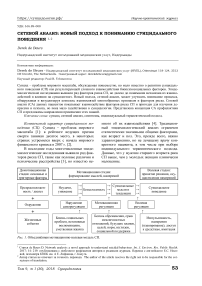Сетевой анализ: новый подход к пониманию суицидального поведения
Бесплатный доступ
Суицид - проблема мирового масштаба, обсуждаемая повсеместно, но мало известно о развитии суицидального поведения (СП) как результирующей сложного взаимодействия биопсихосоциальных факторов. Эпидемиологические исследования выявили ряд факторов риска СП, но далеко до понимания механизма их взаимодействий и влияния на суицидогенез. Новый подход, сетевой анализ, может улучшить понимание процесса, обнаруживая и визуализируя комплекс взаимосвязей многообразных признаков и факторов риска. Сетевой анализ (СА) данных пациентов показывает взаимодействие факторов риска СП и пригоден для изучения депрессии и психоза, но пока мало задействован в суицидологии. Представлена концепция СА профилактики СП и предложены направления применения этих знаний.
Суицид, сетевой анализ, симптомы, индивидуальный терапевтический подход
Короткий адрес: https://sciup.org/140225875
IDR: 140225875
Список литературы Сетевой анализ: новый подход к пониманию суицидального поведения
- WHO. World Health Organization Public Health Action for the Prevention of Suicide. Available online: http://www.who.int/rn. 2012.
- Oyesanya M., Lopez-Morinigo J., Dutta R. Systematic review of suicide in economic recession. World J. Psychiatry. 2015; 5: 243-54.
- Hawton K., van Heeringen K. Suicide. Lancet. 2009; 373: 1372-81.
- O’Connor R.C., Nock M.K. The psychology of suicidal behavior. Lancet Psychiatry. 2014; 1: 73-85.
- O’connor R.C. Towards an Integrated Motivational-Volitional Model of Suicidal Behaviour. In International Handbook of Suicide Prevention: Research, Policy and Practice. -USA, NJ, Wiley-Blackwell: Hoboken. 2011: 181-98.
- O’Connor R.C., Smyth R., Williams J.M.G. Intrapersonal positive future thinking predicts repeat suicide attempts in hospital-treated suicide attempters. J. Consult. Clin. Psychol. 2015; 83: 169-76.
- O’Connor R.C., Rasmussen S., Hawton K. Distinguishing adolescents who think about self-harm from those who engage in self-harm. Br. J. Psychiatry. 2012; 200: 330-5.
- Borsboom D., Cramer A.O.J. Network Analysis: An Integrative Approach to the Structure of Psychopathology. Ann. Rev. Clin. Psychol. 2013; 9: 91-121.
- Fried E.I., van Borkulo C.D., Cramer A.O.J. et al. Mental disorders as networks of problems: A review of recent insights. Soc. Psychiatry Psychiatr. Epidem. 2016; 58: 7250-7.
- Oquendo M.A., Baca-Garcia E. Suicidal behavior disorder as a diagnostic entity in the DSM-5 classification system: Advantages outweigh limitations. World Psychiatry. 2014; 13: 128-30.
- Epskamp S., Cramer A.O.J., Waldrop L.J. et al. Network visualizations of relationships in psychometric data. J. Stat. Soft. 2012; 48: 1-18.
- Costantini G., Epskamp S., Borsboom D. et al. State of the aRt personality research: A tutorial on network analysis of personality data. R. J. Res. Personal. 2015; 54: 13-29.
- Van Borkulo C.D., Borsboom D., Epskamp S. et al. A new method for constructing networks from binary data. Sci. Rep. 2014; 4: 5918.
- Epskamp S., Rhemtulla M., Borsboom D. Generalized Network Psychometrics: Combining Network and Latent Variable Models. arXiv:1605.09288.
- Epskamp S., Borsboom D., Fried E.I. Estimating Psychological Networks and their Stability: A Tutorial Paper. arXiv: 1604.08462.
- De Beurs D.P., Hooiveld M., Kerkhof A.J. et al. Trends in suicidal behaviour in Dutch general practice 1983-2013: A retrospective observational study. BMJ Open. 2016; 6: e010868.
- Fried E.I., Nesse R.M., Zivin K. et al. Depression is more than the sum score of its parts: Individual DSM symptoms have different risk factors. Psychol. Med. 2013; 44: 2067-76.
- De Beurs D.P., de Groot M.H., de Keijser J. et al. Evaluation of benefit to patients of training mental health professionals in suicide guidelines: Cluster randomised trial. Br. J. Psychiatry. 2015; 208: 477-83.
- Dhingra K., Boduszek D., O’Connor R.C. A structural test of the Integrated Motivational-Volitional model of suicidal behavior. Psychiatry Res. 2016; 239: 169-78.
- Van Borkulo C., Boschloo L., Borsboom D. et al. Association of Symptom Network Structure with the Course of Longitudinal Depression. JAMA Psychiatry. 2015; 72: 1219-26.
- Rpackage Network Comparison Test. Available online: https://cran.r-project.org/web/packages/
- De Beurs D., Kirtley O., Kerkhof A. et al. The role of mobile phone technology in understanding and preventing suicidal behavior. Crisis J. Crisis Interv. Suicide Prev. 2015; 36: 79-82.
- Bak M., Drukker M., Hasmi L. et al. An n=1 Clinical network analysis of symptoms and treatment in psychosis. PLoS ONE. 2016; 11: e0162811.
- Isvoranu A.M., van Borkulo C.D., Boyette L.L. et al. Network Approach to Psychosis: Pathways between Childhood Trauma and Psychotic Symptoms. Schizophr. Bull. 2016; 43: 187-96.
- Pescosolido B.A., Georgianna S. Durkheim, Suicide, and Religion: Toward a Network Theory of Suicide. Am. Sociol. Rev. 1989; 54: 33-48.
- Stack S. Suicide: A 15 Year Review of the Sociological Literature: Part II: Modernization and Social Integration Perspectives. Suicide Life Threat. Behav. 2000; 30: 163-76.
- Penninx B.W.J.H., Beekman A.T.F. et al. The Netherlands Study of Depression and Anxiety (NESDA): Rationale, objectives and methods. Int. J. Methods Psychiatr. Res. 2008; 17: 121-40.
- Vancayseele N., Portzky G., Van Heeringen K. Increase in selfinjury as a method of self-harm in Ghent, Belgium: 1987-2013. PLoS ONE. 2016; 11: e0156711.
- Terluin B., De Boer M.R., De Vet H.C.W. Differences in connection strength between mental symptoms might be explained by differences in variance: Reanalysis of network data did not confirm staging. PLoS ONE. 2016; 11: e0155205.
- Chekroud A.M., Zotti R.J., Shehzad Z. et al. Cross-trial prediction of treatment outcome in depression: A machine learning approach. Lancet Psychiatry. 2016; 3: 243-50.


